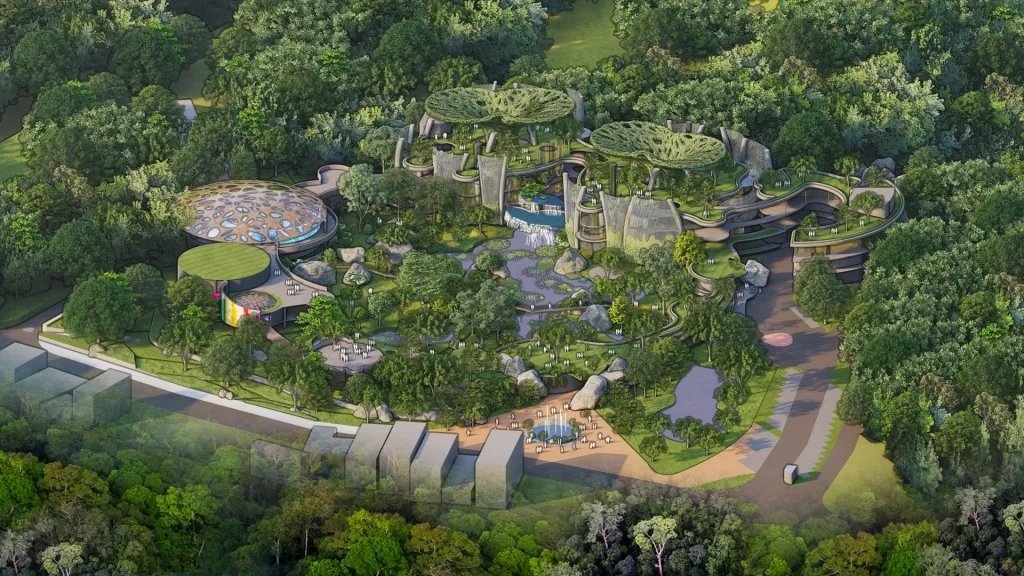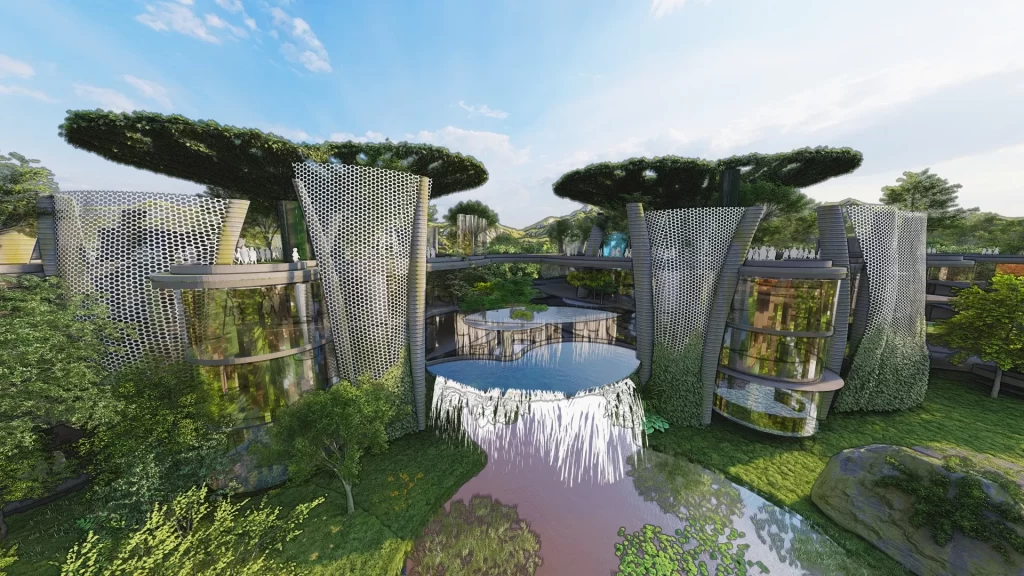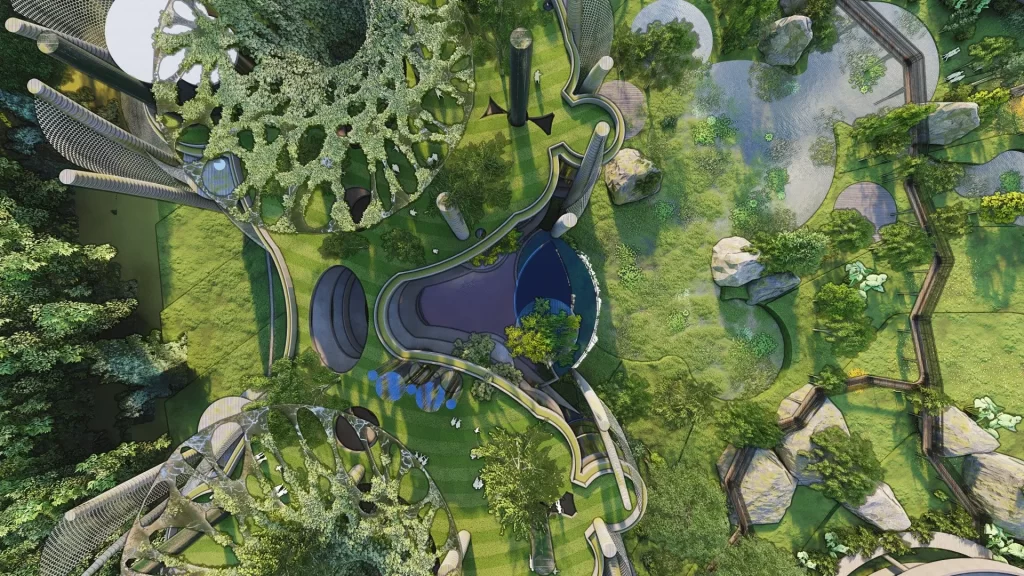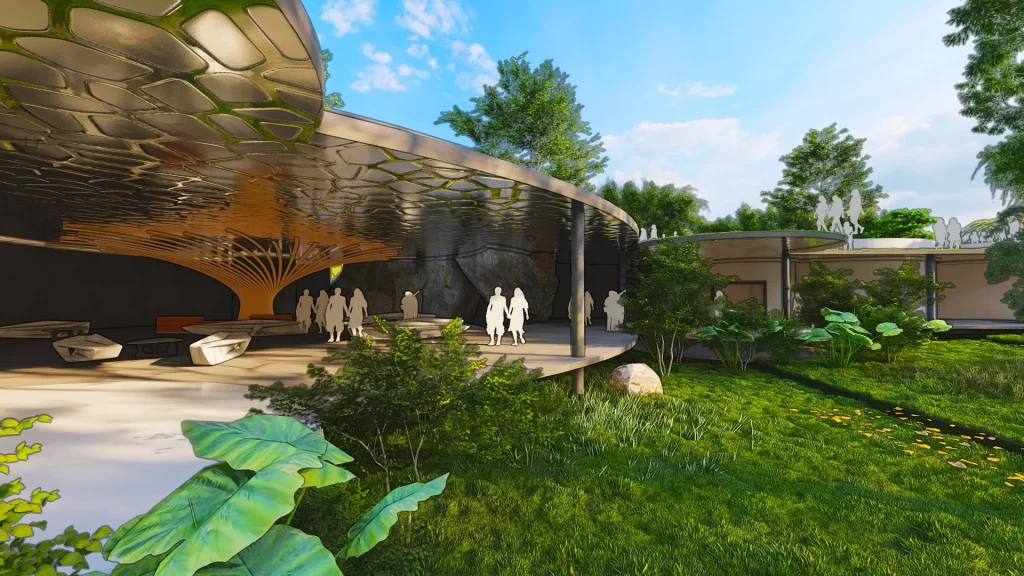BACK TO finale_winnerS
Nippon Paint Colour Award
PROJECT BHUMI ”A MYCO-BIOCENOSIS HAVEN”
Center for Research and Conservation of Indigenous Amphibians and Freshwater Fish in Wet zones of Sri Lanka. The universe is an endless expanse that stretches beyond our comprehension, serves as a constant reminder of our place within its vast tapestry. Our connection to the universe is not merely existential; it is tangible, rooted in the […]

Center for Research and Conservation of Indigenous Amphibians and Freshwater Fish in Wet zones of Sri Lanka.
The universe is an endless expanse that stretches beyond our comprehension, serves as a constant reminder of our place within its vast tapestry. Our connection to the universe is not merely existential; it is tangible, rooted in the very elements that compose our being. We are, in essence, stardust. The atoms that form the foundation of our bodies were forged in the fiery cores of ancient stars, and the energy sustaining us emanates from the heart of the cosmos. This cosmic connection extends to all life on Earth, including the often-overlooked amphibians and freshwater fish.
In envisioning an architectural concept that harmonizes humans, nature, and fauna in a symbiotic dance, the focus is on myco-technology. This innovative design draws inspiration from the intricate role of fungi in nature, mimicking its biological processes in the construction of buildings. At its core, this visionary design aims to facilitate a harmonious coexistence between inhabitants and the natural world, integrating mycelium structures, biophilic design principles, and sustainable architecture to seamlessly blend with the surroundings. The result is a haven that nurtures both human occupants and the local flora and fauna, promoting ecological conservation and fostering a profound connection between people and the vibrant ecosystems they inhabit.
In an era where ecological consciousness is imperative, architecture emerges as a bridge between human innovation and the harmony of the natural world. Embracing the concept of biomimicry, this architectural venture draws inspiration from nature's brilliance. Biomimicry, the emulation of nature's solutions to human challenges, serves as the guiding principle for this endeavour. Nature, over millions of years, has perfected sustainable designs and systems, offering a blueprint for resilient and regenerative solutions. By understanding and applying these principles, the aim is to create structures that not only harmonize with the environment but actively contribute to its well-being.
Amphibians, the evolutionary bridge between aquatic and terrestrial life, embodies the profound connection between the universe and the natural world. Creatures like frogs and salamanders adapt to their environments, showcasing a marvel of nature with their permeable skin that allows them to breathe, absorb water, and regulate body temperature. Their complex life cycles mirror the intricate dance of water and land, illustrating the delicate balance that characterizes our planet.
At the heart of this visionary architectural concept lies mycelium, the thread-like network of fungi serving as nature's premier decomposer and builder. Mycelium's unique properties make it an ideal candidate for sustainable construction, with the ability to grow and self- assemble into robust structures. The construction process involves combining mycelium with organic waste materials to form a composite material of exceptional structural integrity. This mycelium composite, moldable into various shapes and sizes, minimizes environmental impact, enhances sustainability, and promotes economic benefits through community involvement in its cultivation.
The adaptability and inherent strength of mycelium make it an ideal choice for structural elements, resulting in lightweight yet durable buildings with unique shapes and patterns. Beyond structural benefits, mycelium contributes to the regenerative nature of the architecture, remaining biodegradable as the building ages. This commitment to regenerative architecture aligns with the broader goal of creating built environments that coexist with the natural world.
The mycelium composite's insulating properties enhance the building's energy efficiency, acting as a natural thermal regulator in various climates. This feature reduces dependence on artificial heating and cooling systems, minimizing energy consumption and fostering a sustainable approach to climate control. Additionally, the design incorporates mycelium panels into the façade to provide habitats for amphibians, insects, and birds, contributing to urban biodiversity.
The building is not merely a physical space; it serves as an educational and inspirational hub. Transparent sections in the structure reveal the intricate mycelium network, allowing occupants to witness the beauty and complexity of nature's architectural marvel. Educational programs and exhibits within the building promote awareness about sustainable design, inspiring a broader community to embrace eco-friendly practices.
Biomimicry design, drawing inspiration from nature to solve complex human problems, finds a remarkable example in mycelium-inspired structures. This process mirrors the intricate networks of life on Earth, connecting all living beings in a delicate balance. It is an elegant reminder of the wisdom encoded in nature, offering time-tested solutions to the challenges we face and deepening our connection to the universe.
In conclusion, the universe and the natural world are intricately linked, exemplified in the lives of amphibians and freshwater fish. These creatures reflect the delicate balance of water and land sustaining life on our planet. Biomimicry design, inspired by mycelium and nature's brilliance, showcases sustainable solutions that honour the interconnectedness of the universe. As we explore the universe's mysteries, it allows us to cherish and preserve these invaluable connections, honouring the beauty and resilience of the universe we call home.











Showcase your design to an international audience
SUBMIT NOW
Image: Agrapolis Urban Permaculture Farm by David Johanes Palar
Top
Center for Research and Conservation of Indigenous Amphibians and Freshwater Fish in Wet zones of Sri Lanka.
The universe is an endless expanse that stretches beyond our comprehension, serves as a constant reminder of our place within its vast tapestry. Our connection to the universe is not merely existential; it is tangible, rooted in the very elements that compose our being. We are, in essence, stardust. The atoms that form the foundation of our bodies were forged in the fiery cores of ancient stars, and the energy sustaining us emanates from the heart of the cosmos. This cosmic connection extends to all life on Earth, including the often-overlooked amphibians and freshwater fish.
In envisioning an architectural concept that harmonizes humans, nature, and fauna in a symbiotic dance, the focus is on myco-technology. This innovative design draws inspiration from the intricate role of fungi in nature, mimicking its biological processes in the construction of buildings. At its core, this visionary design aims to facilitate a harmonious coexistence between inhabitants and the natural world, integrating mycelium structures, biophilic design principles, and sustainable architecture to seamlessly blend with the surroundings. The result is a haven that nurtures both human occupants and the local flora and fauna, promoting ecological conservation and fostering a profound connection between people and the vibrant ecosystems they inhabit.
In an era where ecological consciousness is imperative, architecture emerges as a bridge between human innovation and the harmony of the natural world. Embracing the concept of biomimicry, this architectural venture draws inspiration from nature's brilliance. Biomimicry, the emulation of nature's solutions to human challenges, serves as the guiding principle for this endeavour. Nature, over millions of years, has perfected sustainable designs and systems, offering a blueprint for resilient and regenerative solutions. By understanding and applying these principles, the aim is to create structures that not only harmonize with the environment but actively contribute to its well-being.
Amphibians, the evolutionary bridge between aquatic and terrestrial life, embodies the profound connection between the universe and the natural world. Creatures like frogs and salamanders adapt to their environments, showcasing a marvel of nature with their permeable skin that allows them to breathe, absorb water, and regulate body temperature. Their complex life cycles mirror the intricate dance of water and land, illustrating the delicate balance that characterizes our planet.
At the heart of this visionary architectural concept lies mycelium, the thread-like network of fungi serving as nature's premier decomposer and builder. Mycelium's unique properties make it an ideal candidate for sustainable construction, with the ability to grow and self- assemble into robust structures. The construction process involves combining mycelium with organic waste materials to form a composite material of exceptional structural integrity. This mycelium composite, moldable into various shapes and sizes, minimizes environmental impact, enhances sustainability, and promotes economic benefits through community involvement in its cultivation.
The adaptability and inherent strength of mycelium make it an ideal choice for structural elements, resulting in lightweight yet durable buildings with unique shapes and patterns. Beyond structural benefits, mycelium contributes to the regenerative nature of the architecture, remaining biodegradable as the building ages. This commitment to regenerative architecture aligns with the broader goal of creating built environments that coexist with the natural world.
The mycelium composite's insulating properties enhance the building's energy efficiency, acting as a natural thermal regulator in various climates. This feature reduces dependence on artificial heating and cooling systems, minimizing energy consumption and fostering a sustainable approach to climate control. Additionally, the design incorporates mycelium panels into the façade to provide habitats for amphibians, insects, and birds, contributing to urban biodiversity.
The building is not merely a physical space; it serves as an educational and inspirational hub. Transparent sections in the structure reveal the intricate mycelium network, allowing occupants to witness the beauty and complexity of nature's architectural marvel. Educational programs and exhibits within the building promote awareness about sustainable design, inspiring a broader community to embrace eco-friendly practices.
Biomimicry design, drawing inspiration from nature to solve complex human problems, finds a remarkable example in mycelium-inspired structures. This process mirrors the intricate networks of life on Earth, connecting all living beings in a delicate balance. It is an elegant reminder of the wisdom encoded in nature, offering time-tested solutions to the challenges we face and deepening our connection to the universe.
In conclusion, the universe and the natural world are intricately linked, exemplified in the lives of amphibians and freshwater fish. These creatures reflect the delicate balance of water and land sustaining life on our planet. Biomimicry design, inspired by mycelium and nature's brilliance, showcases sustainable solutions that honour the interconnectedness of the universe. As we explore the universe's mysteries, it allows us to cherish and preserve these invaluable connections, honouring the beauty and resilience of the universe we call home.










